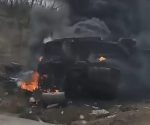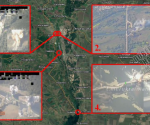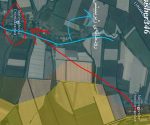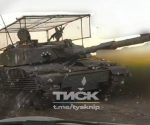No immediate war in Idlib (in a way that benefits Syria), Israel throws a deadly tantrum, tries to get one started
If the reader was ever wondering just how unstable are elements in the anti-Assad and anti-Syria axis of military powers and governments of the Anglo-globalist and satellite/vassal countries, then they were handed a useful demonstration of it on Monday night and into the early hours of Tuesday morning. After all the threats of retaliation for acts of war in the Idlib Governate, Syria was seemingly attacked because it was about to implement a proposal for conflict de-escalation. Earlier on Monday, the Presidents Putin and Erdogan, of Russia and Turkey respectively, fashioned the Idlib demilitarisation zone (with the “general agreement” of Damascus, which has since been officially expressed) – appreciated by some observers as a potential movement towards such reconciliation that would avert the greater part of any violence in the province.
Israel threw a tantrum. The Syrian coastal region, mostly Latakia, was attacked by four Israeli planes so that the Russians supposedly used their own air defences (presumably, then, having decided that there was a threat to their men and materiel at their Khmeimim air base or Tartus naval facility), and a Syrian surface-to-air missile was drawn to explode in the vicinity of a Russian Il-20 (propeller) aircraft which an Israeli F-16 had been “hiding” behind. The Russian MoD has said that Israel’s was an hostile act, and there will be an appropriate response. Maybe Syrian air defences will be upgraded, as many have thought necessary for a long time hitherto.
There is one other detail to cover: the Russians say that the FS Auvergne, the French navy’s newest frigate, launched cruise missiles during the hour long attack [or 90 minutes, depending on the source]. In the author’s opinion, there is a possibility that the Israelis, after some party or other (the ultimate suspect is identified at the foot of this article) had acquired French cooperation for the purpose of being the fall guy, were trying to get the ship sunk in a Russian act of retaliation. RT reports that
Paris denied “any involvement in [the] attack,” a French army spokesman said, as cited by AFP.
In the circumstances suspected here, this should not be a surprise. The reader is also asked to notice that news regarding the attack is dominated by the downing of the Russian plane, and this issue has overshadowed what would have normally been the main concern: the ability of Syrian air defences to counter, or not, Israeli aggression. In fact, quite early on after the attack, Al Jazeera ran a story with the headline “Syrian air defences ‘intercept missiles’ targeting Latakia”. Not so long ago, the story would have been about missiles hitting targets. Therefore, the default idea has become Syria able to defend herself.
As for the motivation for the attack, on September 11th, the Special Envoy of the Russian President to Syria, Alexander Lavrintev, said something significant that may have gone largely unnoticed in the English speaking world:
If we talk about postponement [of the Idlib offensive], the fight against terrorist organizations can be postponed for a week or two or three weeks… But what then? This issue must be resolved radically sooner or later. So it depends on the ability of the international community to help separate the moderate opposition in Idlib from extremists.
According to Muraselon, the Arab language internet news site (via Google Translate), Lavrintev also said that the “separation between the moderate opposition and the militants in the Syrian province of Idlib was the responsibility of Turkey”.
Put simply, the reference is to Turkish Astana agreement commitments to deal with the principle group of jihadists in Idlib, Hayat Tahrir al-Sham (HTS), as a condition whereby that area of Syria has previously been designated a de-escalation zone. Of course, the “Turkish Free Syrian Army”, as one might generally call the Turkish-backed jihadists also in occupation of territory in Idlib (and apparently now unified under the title Jabhat al-Wataniya lil-Tahrir – or National Front for Liberation (NFL)), are variously described as Islamists and Salafists, and are not boy scouts; their not being “extremists” is just a matter of political semantics.
Having become (re)appraised the situation as it was prior to the Idlib demilitarisation zone – or though it would be better described as a corridor – let’s examine the view of what it would mean, especially for Turkey, as posited by “expertise of a Washington-based think-tank. The following is from The National (the “MiddleEast’s leading English language news service”):
Charles Lister, senior fellow and director of the extremism and counter-terrorism programme at the Middle East Institute, suggested it would give Turkey more time to break up the HTS and isolate the hardcore elements.
“More than anything, this gives Turkey more time (and more leverage) to manipulate conditions in Idlib and to further exacerbate HTS’s internal divisions and work towards separating acceptable/irreconcilable,” he wrote on Twitter.
So, the Idlib de-escalation corridor is really an expression of an agreement already made, and practical progress in its implementation. Nothing really has changed, except it will become harder for the Anglo-globalists to utilise their HTS mercenaries out of Idlib. Examine Putin’s statement about the arrangements:
We reviewed the situation in detail and decided to establish by October 15 a demilitartised area 15–20 km deep along the contact line between the armed opposition and government troops, with radical militants to be withdrawn from the area, including al-Nusra. Also by October 10, based on the Turkish President’s proposal, to secure the withdrawal of heavy military equipment, tanks, multiple rocket launchers, cannon and mortars of all opposition groups. Turkish mobile patrol groups and Russian military police units will conduct the monitoring of the demilitarised zone. Also to restore transit along the Aleppo-Latakia and Aleppo-Hama routes before the end of 2018, also at the suggestion of the Turkish side.
Some people drawing maps and posting them to Twitter may have misunderstood. It appears that the corridor starts at current Syrian Army positions*. It will only be the “militants” that withdraw to create the vacuum. Erdogan appears to confirm this in his post-meeting comments:
“We decided on the establishment of a region that is cleaned of weapons between the areas which are under the control of the opposition and the regime,” said Erdogan, whose administration backs certain rebel groups in Idlib.
“In return, we will ensure that radical groups, which we will designate together with Russia, won’t be active in the relevant area,” he added.
Perhaps we can envision, then, one corridor, between 7½ and 10 km deep, tended by the Russians that won’t have any opposition groups in it at all. On the “Idlib side” of that, there will be another corridor of a similar width where Turkey will only permit the NFL to operate. Potentially, HTS will be cleared entirely from southern Idlib, and also squeezed dramatically in the east and west so that the big roads that Putin talks about will fall outside of HTS control and become operational for the Syrian government. Look again at Charles Lister’s tweet now that the setback for HTS has become more apparent, and imagine the scale of internecine tension that there might well be.
Additionally, the situation will have been created whereby Turkey, a NATO power, will be guarding the perimeter of Idlib against any kind of “break out”. In the previous FBEL article on the subject of Idlib, it was suggested that:
Perhaps, then, the Americans want the Russians to think they want to bomb the Syrians in support of a break-out of Idlib by HTS. What we shouldn’t assume, however, is that the Americans are sure that it would be something that they could achieve. It could be bluffing all for the purpose of getting a better deal. Of course, the way Russia should respond is exactly how they have done: act to deny the bargaining chip so that the US has nothing to deal with – hence the warning of a false flag to come, and a strengthened naval contingent.
The focus has been on HTS as US/UK proxies for the sake of simplicity, but of course, it wouldn’t be HTS alone that could take advantage of a bombardment of Syrian positions, and contribute to a reversal in the Syrian Government’s fortunes. What the Idlib corridor constitutes, in terms of the idea introduced in the extract, is another denial of bargaining capacity to the US. Now NATO’s Turkey would be the first line of separation between the US’ proxy force and the target Syrians. Russia would be the second. Idlib would be sealed off and hermetically separated from being able to influence events in the rest of Syria – if Turkey can implement the agreement. And as far as that goes, the intriguing question is this: will the Turks and their FSA elements have to fight HTS? The reader may have noticed that there is a deadline for the establishment of the de-militarisation areas, so any fighting would not be too far away. Ultimately, if the Turks are not capable, there can by no more excused for the Syrians executing their own campaign as planned.
On the other hand, even with implementation of the demilitarisation areas – or during the process of their being set up – Idlib could become a broiling pressure cooker environment that would throw out the civilian population as excess steam, with factions losing control of populations who therefore become willing and able to reconcile with the central Government (as a matter of fact, a desire to reconcile already exists – but is hard to gauge because the jihdist administrations in Idlib do arrest people who are thought to be that way inclined).
Finally, all the focus on Idlib means that it is easy to forget the struggle currently happening in the south and south east of Syria, where it appears as if the US has reached a make-or-break moment with regards controlling the Syrian border with Iraq. Fighting has been rolling to-and-fro across the Badiyah between ISIS and the Syrians – there has been a real risk of ISIS (no doubt not rejuvinated without American approval) making a success of the offensive it launched this month. The US-backed Syrian Democratic Forces (SDF) are making a show of the Euphrates basin being transferred into their control by ISIS. For the Americans, the point of retaining that ISIS pocket was to maintain a rationale for its al-Tanf base, which was to be the source of an excursion by US-proxies to mop up ISIS all the way to the western bank of the Euphrates behind al-Bukamal (a significant prize, therefore, for the Syrians when they recaptured it first). However, a not insignificant portion of the forces that the US has been keeping at the Rukban refugee camp are going to be moved to Turkish occupied Syria in the north. Southfront cites the Syrian Observatory for Human Rights (SOHR) [the lad in Coventry]:
The Damascus government and the US-backed al-Qaryatayn Martyrs Brigade have reached an evacuation agreement, under which the group’s fighters and around 5,000 civilians will be allowed to withdraw from the Rukban refugee camp, south of the border area of al-Tanaf, to the Euphrates Shield-held area in the northern Aleppo countryside.
Arguably, with Syrian forces massed against Idlib, any US airstrike on the south of Syria at this time (launched on the pretext of answering a chemical weapons false flag) may well have had an impact on the course of the fighting in the Badiyah to the Syrian Government’s detriment. As it is, with American options further restricted by the Idlib corridor, it starts to look like al-Tanf is going to become redundant.
All things considered, then, it would be a mistake to assume that the Israelis were throwing their tantrum on their own behalf when they bombed Latakia. Analysts much cleverer than this article’s writer have said that Israel can’t act militarily without the go-ahead from the US Government. Russia may well be summoning the Israeli ambassador for a ticking-off, but it was the American baby, ultimately, whose toys were being thrown out of its pram.
* Update, 19th September:
People on Twitter think they have got hold of the “Memorandum on Stabilization of the Situation in the Idlib De-escalation Area” which stipulates the terms of the agreement between Putin and Erdogan. It says:
All tanks, MLRS, artillery and mortars belonging to conflicting parties will be withdrawn from the demilitarized zone by October 10, 2018
However, it also says:
The delineation of exact lines of the demilitarized zone will be determined through further consultations
Odd that. Erdogan signs up to a job without understanding how big it is.


















